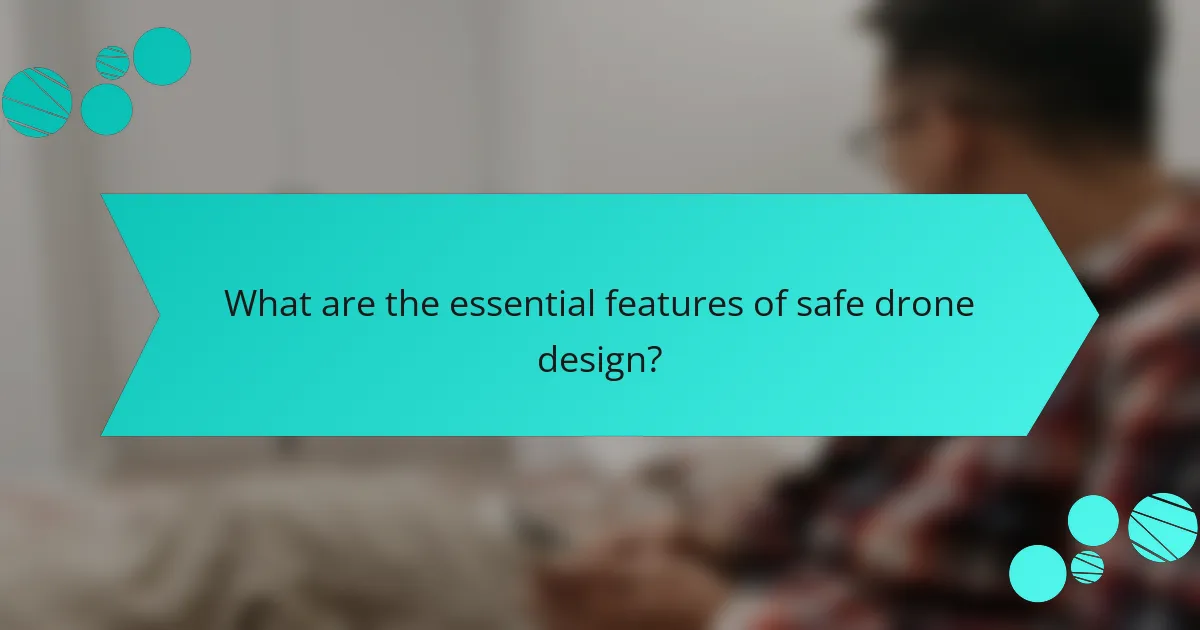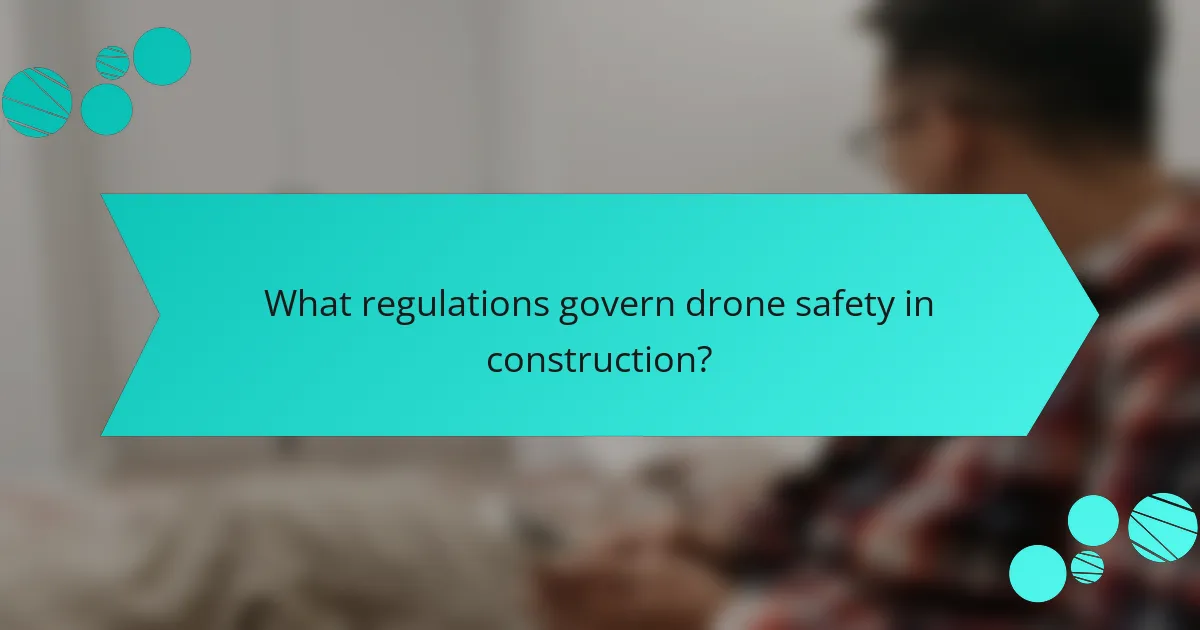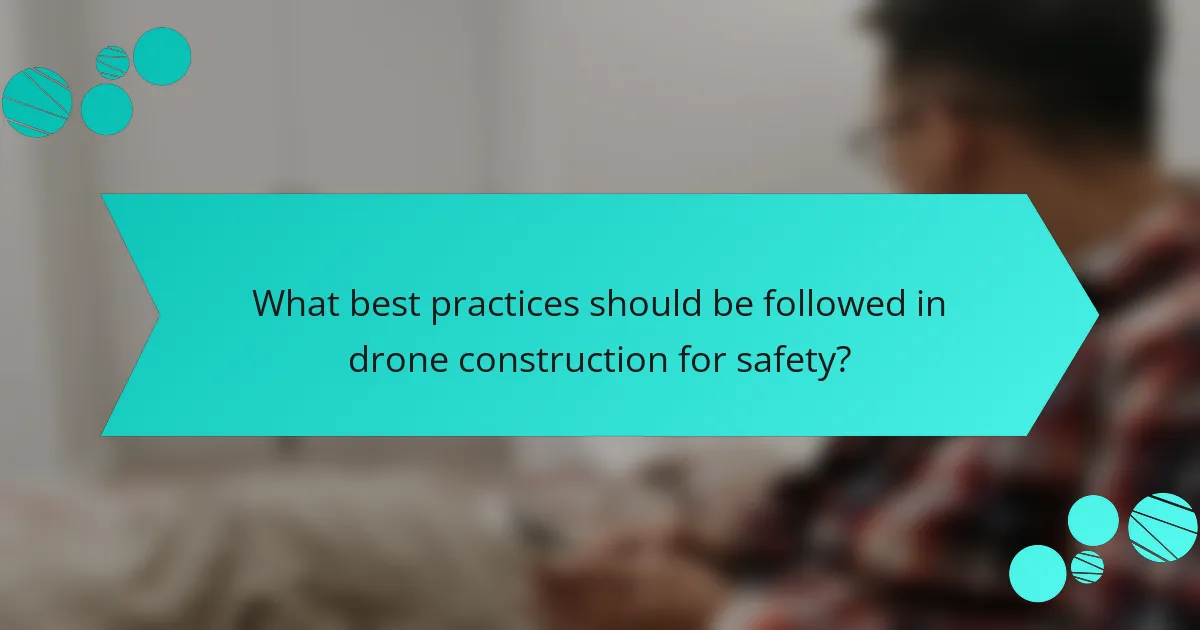
What are the essential features of safe drone design?
Safe drone design includes robust structural integrity, reliable fail-safe systems, and effective communication protocols. Structural integrity ensures that the drone can withstand operational stresses and impacts. This is achieved through the use of durable materials and thoughtful design. Reliable fail-safe systems automatically land or return the drone in case of malfunction. These systems reduce the risk of crashes and potential injuries. Effective communication protocols maintain a stable connection between the drone and the operator. This includes real-time telemetry and control signals. Additionally, compliance with aviation regulations enhances safety standards. Regulations often require features like geofencing to prevent unauthorized flights. Together, these features contribute to the overall safety of drone operations.
How do these features enhance safety during operation?
Safety features in drone design enhance operational safety by minimizing risks and preventing accidents. These features include redundant systems, which ensure that if one component fails, another can take over. For instance, dual battery systems provide backup power, preventing loss of control during flight.
Geofencing technology restricts drones from entering hazardous areas, reducing the risk of collisions. Collision avoidance systems use sensors to detect obstacles, allowing the drone to navigate safely. These systems have been shown to decrease accident rates significantly.
Additionally, fail-safe mechanisms automatically land the drone in case of critical failures. Regular software updates improve safety by addressing vulnerabilities. Collectively, these features create a robust framework that enhances safety during drone operation.
What materials are commonly used to improve drone safety?
Common materials used to improve drone safety include carbon fiber, aluminum, and high-strength plastics. Carbon fiber is lightweight and has high tensile strength, enhancing structural integrity. Aluminum provides durability and resistance to corrosion. High-strength plastics, such as polycarbonate, offer impact resistance and flexibility. These materials contribute to crash resistance and overall safety during operations. Their properties are essential for minimizing damage in the event of an accident.
How does the design affect the drone’s stability and control?
The design of a drone significantly impacts its stability and control. Aerodynamic shapes reduce drag and enhance stability during flight. The placement of motors and propellers affects balance and maneuverability. A lower center of gravity improves stability against tipping. Materials used in construction influence weight distribution and structural integrity. For instance, carbon fiber is lightweight yet strong, contributing to better control. Additionally, the design of the flight control system determines responsiveness to pilot inputs. Sensors integrated into the design help maintain stability in varying conditions. Overall, thoughtful design directly correlates with improved flight performance and safety.
What role does redundancy play in drone safety?
Redundancy enhances drone safety by providing backup systems for critical components. This ensures continued operation even if a primary system fails. For example, dual communication links maintain control if one link is compromised. Redundant sensors allow for accurate data collection despite potential sensor failure. The presence of multiple power sources prevents loss of function due to battery failure. According to the Federal Aviation Administration (FAA), redundancy is crucial for maintaining safety standards in unmanned aircraft systems. Studies show that drones with redundant systems have significantly lower accident rates. Thus, redundancy is integral to reliable drone operation and overall safety.
How can redundancy in systems prevent failures?
Redundancy in systems prevents failures by providing backup components or processes. This ensures that if one part fails, another can take over. In drone construction, redundancy can involve multiple sensors or control systems. For example, if a primary sensor fails, a secondary sensor can maintain functionality. This design approach enhances reliability and safety. Studies show that systems with redundancy have lower failure rates. For instance, aerospace systems often utilize redundancy to ensure operational integrity. By incorporating redundancy, the likelihood of catastrophic failure decreases significantly.
What examples of redundancy are commonly implemented in drones?
Common examples of redundancy implemented in drones include dual motor systems and multiple sensors. Dual motor systems ensure that if one motor fails, the other can maintain flight stability. Multiple sensors, such as GPS and inertial measurement units, provide backup navigation data. Redundant power supplies can also keep the drone operational if one battery fails. Additionally, some drones have multiple communication links to maintain control even if one link is disrupted. These redundancy measures enhance safety and reliability during operation.

What regulations govern drone safety in construction?
Drone safety in construction is governed primarily by the Federal Aviation Administration (FAA) regulations. The FAA requires that drone operators obtain a Remote Pilot Certificate under Part 107. This certification ensures that operators understand airspace rules and safety protocols. Additionally, construction sites must adhere to local and state regulations regarding drone use. These regulations often include restrictions on flight altitude and proximity to people and structures. Compliance with the National Institute for Occupational Safety and Health (NIOSH) guidelines is also essential for ensuring workplace safety. Furthermore, construction companies may implement their own safety protocols to mitigate risks associated with drone operations.
How do these regulations vary by region?
Regulations for drone construction vary significantly by region. In the United States, the Federal Aviation Administration (FAA) governs drone use, emphasizing safety and airspace management. In Europe, the European Union Aviation Safety Agency (EASA) sets regulations that focus on harmonization across member states. Countries like Canada have their own regulations under Transport Canada, which also prioritize safety but may differ in operational restrictions. Additionally, regions like Asia may have varying degrees of regulation, with countries such as Japan and China implementing strict guidelines. These differences stem from local airspace needs, technological advancements, and safety concerns.
What are the key regulatory bodies involved in drone safety?
The key regulatory bodies involved in drone safety include the Federal Aviation Administration (FAA) in the United States. The FAA establishes regulations and guidelines for drone operations. In Europe, the European Union Aviation Safety Agency (EASA) oversees drone safety regulations. The Civil Aviation Safety Authority (CASA) regulates drone use in Australia. Transport Canada is responsible for drone safety regulations in Canada. Each of these organizations sets standards to ensure safe drone operation within their jurisdictions.
How can drone manufacturers ensure compliance with these regulations?
Drone manufacturers can ensure compliance with regulations by implementing rigorous testing protocols. They should conduct thorough assessments of drone designs against regulatory standards. Regular audits of manufacturing processes help maintain adherence to safety requirements. Manufacturers must stay updated on evolving regulations and industry best practices. Training staff on compliance measures is crucial for effective implementation. Collaborating with regulatory bodies can provide insights into compliance expectations. Utilizing advanced technology for real-time monitoring enhances compliance efforts. Documenting all processes and modifications ensures traceability and accountability.
What are the penalties for non-compliance with drone safety regulations?
Penalties for non-compliance with drone safety regulations can include fines, suspension of license, and criminal charges. The Federal Aviation Administration (FAA) can impose civil penalties up to $30,000 for serious violations. In addition, operators may face criminal charges leading to imprisonment for willful neglect of safety regulations. Non-compliance can also result in the revocation of the drone operator’s certification. These measures ensure adherence to safety standards and promote responsible drone usage.
How can companies mitigate risks associated with regulatory violations?
Companies can mitigate risks associated with regulatory violations by implementing comprehensive compliance programs. These programs should include regular training for employees on relevant regulations. Companies must also conduct periodic audits to identify potential compliance gaps. Engaging legal counsel to review practices ensures adherence to regulations. Establishing clear reporting mechanisms encourages employees to report violations. Documenting compliance efforts provides evidence of due diligence. Additionally, companies should stay updated on regulatory changes to adapt practices accordingly. Implementing these strategies reduces the likelihood of violations and associated penalties.

What best practices should be followed in drone construction for safety?
Best practices in drone construction for safety include using high-quality materials and components. Ensuring structural integrity is crucial for preventing failures during operation. Incorporating redundancy in critical systems enhances reliability. Implementing fail-safe mechanisms can mitigate risks during malfunctions. Regular testing and quality assurance processes are essential for maintaining safety standards. Adhering to industry regulations and guidelines helps ensure compliance. Continuous training for personnel involved in construction promotes safety awareness. Finally, conducting thorough risk assessments before deployment identifies potential hazards.
How can manufacturers implement safety protocols during the design phase?
Manufacturers can implement safety protocols during the design phase by integrating risk assessment processes. This involves identifying potential hazards associated with the drone’s components and functionalities. Manufacturers should utilize design reviews to evaluate safety considerations at each stage. Conducting simulations and testing prototypes can help identify design flaws that may pose safety risks. Additionally, adhering to industry standards and regulations ensures compliance with safety requirements. Implementing feedback loops from testing can refine safety measures in design. Documenting all safety protocols and design decisions is crucial for accountability and traceability. These practices collectively enhance the safety of drone construction.
What testing procedures are essential for ensuring safety in drone design?
Essential testing procedures for ensuring safety in drone design include structural integrity testing, flight stability testing, and battery safety testing. Structural integrity testing assesses the durability of materials under various stress conditions. Flight stability testing evaluates the drone’s performance during maneuvers and adverse weather. Battery safety testing ensures the power source does not pose fire or explosion risks. Additionally, electromagnetic interference testing checks for potential disruptions in communication systems. These procedures help identify vulnerabilities and ensure compliance with safety standards. For instance, the Federal Aviation Administration (FAA) emphasizes the importance of rigorous testing to mitigate risks associated with drone operations.
How can user feedback improve safety features in drone design?
User feedback can significantly improve safety features in drone design by identifying real-world issues. Users often encounter problems that designers may overlook. Their experiences provide insights into potential hazards and usability challenges. For example, feedback can reveal shortcomings in obstacle detection systems. This can lead to enhancements that prevent collisions. Additionally, users can suggest improvements based on their operational environments. Implementing these suggestions can increase reliability and safety. Studies show that incorporating user feedback can reduce incident rates by up to 30%. Therefore, engaging users in the design process is crucial for developing safer drones.
What are common troubleshooting tips for ensuring drone safety?
Common troubleshooting tips for ensuring drone safety include performing pre-flight checks. Inspect the drone for physical damage before each flight. Ensure that the battery is fully charged and properly connected. Calibrate the drone’s sensors and compass regularly. Check for firmware updates and apply them as needed. Monitor weather conditions to avoid flying in adverse conditions. Maintain a clear line of sight with the drone during operation. Familiarize yourself with local regulations regarding drone use. These practices help prevent accidents and ensure safe operation.
The main entity of the article is drone construction, specifically focusing on safety features, regulations, and best practices. The article outlines essential design elements that enhance drone safety, including structural integrity, fail-safe systems, and effective communication protocols. It also discusses the role of redundancy in systems, materials used for safety improvements, and regulatory compliance requirements. Additionally, best practices for drone construction and testing procedures are highlighted, emphasizing the importance of user feedback and thorough risk assessments to ensure operational safety.



